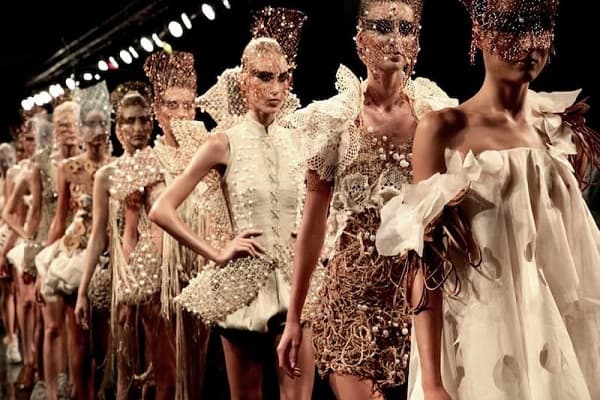8 Famous Designers Who Marked The History Of Fashion
Here is a list of the 8 famous designers who marked the history of fashion. To understand how we got to what the fashion industry is today, we must know a little about its history and how it went from being a primary need to have something to wear to a symbol of protest, comfort and status.
It is incredible to think how in less than 100 years fashion has totally changed from corsets and long dresses to contemporary fashion, which increasingly values comfort today.

We are going to talk about the most famous designers in history, these are not necessarily the designers we know today, but they are the ones who built the fashion industry with their revolutionary contributions in each era.
Famous Designers Who Marked the History of Fashion
1. Charles Frederick Worth
Worth is known as the first fashion designer, who dominated the Parisian industry in the late nineteenth century. He was born in Lincolnshire, England in 1825.
From a very young age Worth worked in large textile companies in England, which gave him a great knowledge of textiles, as well as the manufacture and sale of dresses in his time.
In 1845 he moved to Paris and began working with the Gagelin textile company, where he soon became the best salesman and had the opportunity to open a small sewing department, this was his first job making clothes.
Thanks to his success in the business with award-winning designs, he gained the recognition necessary to open his own firm in 1858. In 1852 the restoration of Napoleon’s second empire in France began, which made Paris an exemplary destination in Europe, this generated a great demand for luxury dresses and Empress Eugénie, Napoleon’s wife, chose Worth as her main designer.
2. Jacques Doucet
Jacques Doucet was born in Paris in 1853, in the midst of the best fashion stores at the beginning of the 20th century. From a very young age he loved art and fashion, with friends such as the children of designer Frederick Worth.
His beginnings in fashion were with luxury lingerie and accessories, in 1875 he opened his haute couture house, with striking and extravagant designs, which attracted the attention of women who were looking for wealthy suitors.
He was well known for his handling of pastel tones, the best quality fabrics, lace and embroidery.
Doucet is known as the “creator of haute couture” because he was the first to sign his pieces as a work of art and also created the floral silhouette for women, with less volume where women’s clothing begins to be more comfortable.
He was also a mentor to several emerging designers who revolutionized the fashion industry, such as Paul Poiret and Madeline Vionet.
3. Paul Poiret
Although not widely recognized today, Paul Poiret was one of the greatest revolutionaries of women’s fashion.
Born in Paris in 1879, he was called “the king of fashion” because his contributions created the foundation for modern fashion.
His career began by selling his drawings of dresses to large fashion houses such as Ducet and Worth, then he was hired as an assistant designer at the Worth house, but due to the lack of creative freedom in this position, he decided to open his fashion house in 1903.
Poiret was responsible for women’s liberation in clothing, disappearing the corset and creating the barrel-shaped silhouette, wide at the waist and the half-step skirt. He brings back the empire cut and his designs are much more comfortable and loose. Inspired by the Japanese Kimono, the midwestern caftan and turbans. His favorite accessories were tassels, capes, feathers, stoles, and fox furs.
It also creates the spectacle of catwalks and the idea of fashion brands as a symbol of a life of luxury and status.
He was the most important fashion designer in the pre-war era, however after the war he did not know how to adapt to the changes of the time and his fame was declining until it became obsolete in part due to the emergence of the greatest designer of twentieth-century fashion, Gabrielle Chanel.
4. Gabrielle Chanel
Gabrielle Chanel, better known as Coco Chanel, was born in 1883 in Saumur, France. She was the designer who dominated Parisian Haute Couture for over 60 years. Due to her elegant, comfortable and casual designs.
She was the creator of the simplest feminine dress in history with a knee-length skirt and straight waist, called the table silhouette. She inspiring women around the world to abandon those uncomfortable and complicated garments such as corsets and skirts.
His greatest contributions were “the little black dress” (little black dress), the suit for women, the quilted bag and personalized jewelry.
Chanel is the world’s leading fashion reference that does not need much description, Gabrielle was a completely revolutionary and advanced woman for her time, who brought some of the best changes in women’s fashion as we know it today.
5. Yves Saint Laurent
He was born in Oran, Algeria in 1936 in one of the richest families in the city, in 1950 Saint Laurent participated in a contest with his designs and won, due to this his talent reached the hands of Cristian Dior and at 18 years old he began to work with this firm.
In 1957, to his surprise, Dior chose him as his successor at only 21 years of age, being the youngest French haute couture designer.
In 1960 he was called up for military service in France in which he only lasted 20 days due to psychological problems and after a time at the psychiatrist he returned to Dior and his position was removed, when he sued Dior for the damages caused he received the money with the who opens his fashion house.
As an independent designer, he is considered the creator of many iconic styles of twentieth century fashion, the A-line or trapeze silhouette, the women’s tuxedo in 1966, the Mondrian dress in 1965, the safari jacket in 1969, and is considered to be responsible for the revival of haute couture in 1980.
6. Christian Dior
Christian Dios was born in Granville, France in 1905, he was the most important designer after the Second World War creating the New Look silhouette in 1946, a style that returns femininity to women after the masculinized clothing that the war had left.
This look consisted of a rounded wide skirt below the knee, a very marked wasp waist and round shoulders with an X silhouette.
Dior was a great visionary who in just 20 years expanded his brand to 15 countries, with more than 2,000 employees and offering many more luxury products, such as perfumes, jewelry, bags and shoes.
In 1957 Cristian Dior dies and is replaced by his disciple Ive Saint Laurent.
The house of Dior is still currently one of the most important fashion houses in the world that dresses the most influential people.
7. Cristobal Balenciaga
Balenciaga was born in Guetaria, Spain, recognized as one of the most important creators of haute couture. He is the most important Spanish fashion designer in history, who worked mainly for more than thirty years in Paris.
His mother was a seamstress and since he was a child he dreamed of being a dressmaker. At the age of thirteen, the Marchioness of Casa Torres took him in to develop his talent.
In 1916 he opened his first sewing workshop in San Sebastián, which later expanded to Madrid and Barcelona, the royal family and the most influential people wore his designs until the arrival of the civil war when he was forced to move to Paris.
In 1968 he retired and at the same time closed the Balenciaga haute couture house, however the brand is still in force, adapting to the present with more modern and urban designs.
8. Jean-Paul Goutier
He was born in Arcueil, France in 1952, known as “the rebellious boy of fashion” because he does not follow the traditional social standards for his designs, he never studied anything about fashion but due to his talent in design he was hired by Pier Cardin in 1970, he was also creative director of hermes and his first independent collection was in 1976 where he became known for his irreverent and modern style.
Many of his collections were inspired by urban and streetwear, with unusual designs that led him to work with the singer Madonna in 1990.
Known for promoting controversial styles such as skirts for men, the use of models with non-traditional bodies in the industry at this time, older people, with tattoos and piercings, playing with genders, which generated a lot of criticism but also its great popularity.
Read Also: The 10 Most Expensive Clothing Brands In The World
There are many more important fashion designers, but these are the most important ones who marked very important eras in the history of fashion due to their contributions and creativity.







Thank you for your sharing. I am worried that I lack creative ideas. It is your article that makes me full of hope. Thank you. But, I have a question, can you help me?
Your point of view caught my eye and was very interesting. Thanks. I have a question for you.
I am really impressed along with your writing skills
and also with the format for your weblog. Is that this a paid topic or did you customize it yourself?
Anyway keep up the excellent quality writing, it is uncommon to look
a great blog like this one nowadays. HeyGen!
Your point of view caught my eye and was very interesting. Thanks. I have a question for you.
Your point of view caught my eye and was very interesting. Thanks. I have a question for you.
Your point of view caught my eye and was very interesting. Thanks. I have a question for you.
Your point of view caught my eye and was very interesting. Thanks. I have a question for you. https://www.binance.com/pt-BR/join?ref=YY80CKRN
Can you be more specific about the content of your article? After reading it, I still have some doubts. Hope you can help me.
Your article helped me a lot, is there any more related content? Thanks! https://www.binance.info/uk-UA/register-person?ref=W0BCQMF1
Can you be more specific about the content of your article? After reading it, I still have some doubts. Hope you can help me.